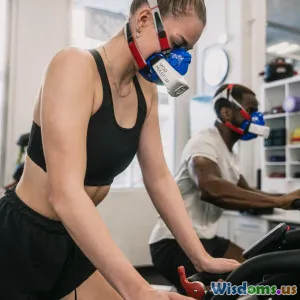Tracking Your VO2 Max The Key to Unlocking Peak Fitness
9 min read Unlock your ultimate fitness potential by mastering VO2 Max tracking—scientifically proven to elevate endurance and performance. (0 Reviews)Tracking Your VO2 Max: The Key to Unlocking Peak Fitness
When it comes to achieving peak fitness, there’s one metric at the forefront of cutting-edge sports science: VO2 Max. For athletes and health enthusiasts alike, VO2 Max isn’t just another number—it’s a window into your body’s aerobic power and an invaluable guide for maximizing endurance, recovery, and overall vitality.
Introduction: What is VO2 Max and Why Should You Care?
VO2 Max stands for "maximal oxygen uptake." It measures the maximum amount of oxygen your body can utilize during intense exercise, typically expressed in milliliters of oxygen consumed per kilogram of body weight per minute (ml/kg/min). But why does this matter?
In essence, VO2 Max represents your aerobic engine’s capacity to generate energy. The higher your VO2 Max, the more oxygen your muscles can use, translating directly into better endurance and performance.
Sports scientists, coaches, and fitness aficionados consider it the gold standard for assessing cardiovascular fitness. Yet despite its importance, many overlook tracking VO2 Max regularly, missing out on feedback critical to tailoring training for continuous improvement.
The Science Behind VO2 Max: How It Reflects Fitness
Understanding VO2 Max requires a peek into how the body produces energy during exercise:
- Oxygen Delivery: Your lungs extract oxygen from the air as you breathe.
- Transport: Your heart pumps oxygen-rich blood to muscles.
- Utilization: Mitochondria inside muscle cells use oxygen to produce ATP—the energy molecule fueling movement.
VO2 Max essentially captures the peak efficiency of this entire system working together.
Factors Influencing VO2 Max
- Genetics: Your hereditary baseline sets a starting point.
- Age: VO2 Max generally declines with age but can be mitigated.
- Training: Aerobic conditioning can raise your VO2 Max by 10-25%.
- Altitude: High altitude can initially lower VO2 Max but stimulate adaptation.
A classic study from the Cooper Institute found that elite endurance athletes often display VO2 Max values above 70 ml/kg/min. Recreationally active individuals usually lie between 35-50 ml/kg/min.
Measuring VO2 Max: Accurate Methods and Emerging Technologies
Laboratory Testing: The Gold Standard
The most precise method involves a graded exercise test on a treadmill or cycle ergometer with direct measurement of inhaled and exhaled gases. Participants wear a face mask connected to a metabolic cart that analyzes oxygen and carbon dioxide levels.
While highly reliable, lab tests are expensive, require specialized equipment, and can be strenuous.
Field Tests: Practical Alternatives
Several empirical approaches estimate VO2 Max without direct gas analysis:
- Cooper 12-Minute Run Test: Distance covered in 12 minutes correlates with VO2 Max.
- 1.5-Mile Run Test: Time taken to cover 1.5 miles converts into an estimated VO2 Max.
- Multi-stage Fitness Test (Beep Test): Progressive shuttle runs to exhaustion estimate aerobic capacity.
Though less precise, these tests are accessible and useful for tracking relative changes over time.
Wearables and Smart Devices
Modern fitness trackers and GPS watches increasingly claim to estimate VO2 Max through algorithms analyzing heart rate, speed, and power data. For example, Garmin and Apple Watch provide VO2 Max scores for runners and cyclists in real time.
While convenient and motivating, these devices come with variability depending on sensor accuracy and user factors such as age and body weight. Nonetheless, they remain valuable for ongoing monitoring.
Why Tracking VO2 Max Matters: Real-World Benefits
Tailoring Training Zones
Knowing your VO2 Max helps define personalized intensity zones for interval, tempo, and recovery workouts, which improves training efficiency. For instance, intervals performed around 90-95% of VO2 Max can dramatically enhance aerobic capacity.
Motivation and Progress Monitoring
Seeing upward trends in VO2 Max scores can reinforce positive behavior changes and deepen commitment.
Early Health Indicator
Beyond sports, research including a 2019 study in the Journal of the American College of Cardiology showed that low VO2 Max is an independent predictor of cardiovascular disease and mortality risk, underscoring its value as a health biomarker.
Recovery and Overtraining Prevention
Significant drops in VO2 Max readings over weeks can warn of fatigue or illness, allowing athletes to adjust rest strategies.
How to Improve Your VO2 Max: Actionable Strategies
High-Intensity Interval Training (HIIT)
Short bursts (>90% max heart rate) followed by recovery periods trigger mitochondrial biogenesis and cardiovascular improvements.
Example: 4 × 4-minute intervals at high intensity with 3 minutes rest can significantly boost VO2 Max within weeks.
Consistent Endurance Training
Steady-state aerobic workouts for 30-60 minutes, 3-5 times per week build a solid aerobic base.
Cross-Training and Variety
Alternating running, cycling, rowing, and swimming prevents plateaus and promotes balanced adaptation.
Strength Training
Building muscular endurance supports more efficient oxygen use during prolonged efforts.
Lifestyle Adjustments
Adequate sleep, nutrition, and avoiding smoking directly affect cardiorespiratory health.
Case Study: How Tracking VO2 Max Transformed an Amateur Runner’s Performance
Jane, a 34-year-old software engineer and weekend runner, initially struggled with stagnating 10k times. After purchasing a smart watch with VO2 Max estimation, she tracked baseline VO2 Max of 38 ml/kg/min.
Using tailored HIIT and endurance sessions guided by her tracking data, Jane steadily increased her VO2 Max to 46 ml/kg/min over six months. Correspondingly, her 10k improved by 12%, illustrating the real-life benefits.
Conclusion: Make VO2 Max Your Fitness Compass
In a fitness landscape crowded with metrics and buzzwords, VO2 Max stands out as a scientifically robust and actionable measure to unlock your peak potential.
By understanding its significance, utilizing available measurement tools, and incorporating targeted training, athletes of all levels can elevate their endurance, stay motivated, and safeguard health. Whether you're chasing a marathon PR or improving general wellbeing, VO2 Max isn’t just a number—it’s the key to a more powerful, efficient you.
Takeaway: Start tracking today, adapt your workouts smartly, and watch your capabilities soar with the power of VO2 Max data.
“VO2 Max isn’t the whole story—but it’s a very important chapter.” – Dr. Jack Daniels, Exercise Physiologist
References
- Midgley, A. W., McNaughton, L. R., & Wilkinson, M. (2007). The effect of prolonged continuous moderate endurance exercise on whole-body VO2max.
- Bassett, D. R., & Howley, E. T. (2000). Limiting factors for maximum oxygen uptake and determinants of endurance performance.
- Journal of the American College of Cardiology, (2019). VO2 Max and cardiovascular disease risk.
- Garmin and Apple Watch official product manuals and whitepapers.
- Cooper Institute. (1995). Aerobic Fitness norms.
Rate the Post
User Reviews
Popular Posts















